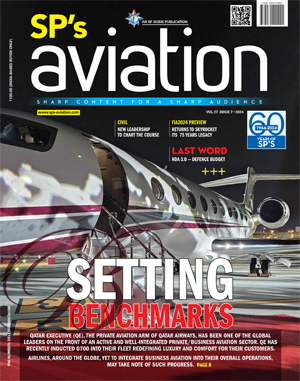INDIAN ARMED FORCES CHIEFS ON
OUR RELENTLESS AND FOCUSED PUBLISHING EFFORTS

SP Guide Publications puts forth a well compiled articulation of issues, pursuits and accomplishments of the Indian Army, over the years

I am confident that SP Guide Publications would continue to inform, inspire and influence.

My compliments to SP Guide Publications for informative and credible reportage on contemporary aerospace issues over the past six decades.
John Northrop (1895 - 1981)
The Vega was a rugged, long-range, six-seat monoplane with a cantilever wing that was responsible for many range and airspeed records

A military aviation enthusiast who occasionally dabbles in palaeontology might be intrigued by the name Quetzalcoatlus northropi. This giant tailless pterosaur (a flying reptile, not a dinosaur) is believed to have ruled the skies of North America around 65 million years ago. Standing as tall as a giraffe and weighing 250 kg, the type species Q. northropi was the largest of all flying creatures ever. Its name honours John Northrop, the founder of Northrop Corporation and one of the leading aircraft designers of the 20th century who drove the development of large tailless flying wings resembling Quetzalcoatlus.
John Knudsen “Jack” Northrop was born on November 10, 1895, in Newark, New Jersey. He later said, “My grammar school and high school education, outside of the school of hard knocks, was the only education I ever had.” But he was a good student and his lack of degrees was more than compensated for by his strong work ethic and drive to succeed. His decision to use his mechanical talent in the nascent aviation industry came when he saw a “pusher” biplane. In 1916, Jack got a job as a draftsman for the Loughead Aircraft Manufacturing Company, ancestor of today’s Lockheed Martin Corporation. During his second stint at Loughead that had been renamed Lockheed, he was the principal designer of the Lockheed Vega. The Vega was a rugged, long-range, six-seat monoplane with a cantilever wing that was responsible for many range and airspeed records. Its remarkable performance made it a favourite of such aviation heroes as Wiley Post, Amelia Earhart and Hubert Wilkins.
However, Northrop’s enduring affair with the flying wing which he was convinced would be the next major stage in aircraft design, began when he founded a completely independent company called the Northrop Corporation in 1939. A flying wing is a tailless fixed-wing aircraft with no prominent fuselage. Crew, fuel, armament and other equipment are all contained inside the main wing structure. But there may be certain small attachments such as pods, nacelles, vertical stabilizers etc. Although it was not considered significant at that time, one of the major attractions of flying wing designs is that they reflect only tiny radar echoes in the head-on aspect. For instance, the huge Northrop Grumman B-2 Spirit stealth bomber paints the size of a bumble bee on radar.
The Northrop Corporation’s first true flying wing was the N-1M in 1940. It was the basis of a prototype bomber, the XB-35, an elegant looking aircraft of polished aluminium. The combined flight controls – “elevons” that functioned as both elevators and ailerons and flaps that acted as rudders were mounted on the trailing edges of the wings. All major parts such as the crew nacelle, fuel tanks and bomb bays were inside the wing. It had contra-rotating propellers, two of them mounted one behind the other on each engine shaft and turning in opposite directions. However, the programme was beset by production delays and disappointing range and speed performance. Besides, with the start of the atomic age an American bomber needed to be able to carry a 10,000-pound atomic bomb and there was no way the XB-35 or even its jet-powered successor the YB-49 could house such a huge weapon in the wing. Of the more conventional designs of the Northrop Corporation, the XP-56 Black Bullet, a welded magnesium fighter was a significant World War II design. And the Northrop P-61 Black Widow, of which more than 700 were built, was the first American night interceptor. After the War came the Northrop F-89 Scorpion all-weather interceptor.
Northrop’s flying wing designs were never brought to fruition because they were decades ahead of the computer and electronic advances that permit inherently unstable aircraft to fly safely using “fly-by-wire” controls. In a fly-by-wire system, the manual flight controls are replaced with an electronic interface. Computers determine how much to move the actuators at each control surface to deliver the ordered response within safety and stability limits.
The failure of the XB-35 and later the YB-49 to be selected as the next generation bomber aircraft, shattered John Northrop. This quiet and gentle genius retired at the age of 57 in 1952 and then tried his hand at real estate, losing a fortune in the process. By the late 1970s, illness left him unable to walk or speak. However, in an unusually humane gesture for the US Air Force, Jack was shown secret drawings and a scale model of the Northrop Grumman B-2, and he recognised how it shared several features of his XB-35 and YB-49. Even the wingspan of 172 feet was similar to that of the YB-49. His lifelong passion for the flying wing finally vindicated, Northrop wrote on a sheet of paper: “Now I know why God has kept me alive for 25 years.” He died ten months later on February 18, 1981.





